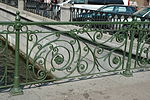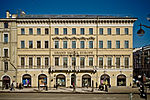Church of the Savior on Blood
20th-century Eastern Orthodox church buildingsArt Nouveau architecture in Saint PetersburgArt Nouveau church buildings in RussiaChurch buildings with domesChurches completed in 1907 ... and 3 more
National Romantic architecture in RussiaRussian Orthodox cathedrals in RussiaRussian Orthodox churches in Saint Petersburg

The Church of the Savior on Spilled Blood (Russian: Церковь Спаса на Крови, Tserkovʹ Spasa na Krovi) is a Russian Orthodox church in Saint Petersburg, Russia which currently functions as a secular museum and church at the same time. The structure was constructed between 1883 and 1907. It is one of Saint Petersburg's major attractions. The church was erected on the site where political nihilists assassinated Emperor Alexander II in March 1881. The church was funded by the Romanov imperial family in honor of Alexander II, and the suffix "on [Spilled] Blood" refers to his assassination.
Excerpt from the Wikipedia article Church of the Savior on Blood (License: CC BY-SA 3.0, Authors, Images).Church of the Savior on Blood
набережная канала Грибоедова, Saint Petersburg
Geographical coordinates (GPS) Address Website External links Nearby Places Show on map
Geographical coordinates (GPS)
| Latitude | Longitude |
|---|---|
| N 59.94 ° | E 30.328611111111 ° |
Address
Собор Воскресения Христова на Крови (Храм Спаса на Крови)
набережная канала Грибоедова 2Б
191186 Saint Petersburg (Palace District)
Saint Petersburg, Russia
Open on Google Maps











